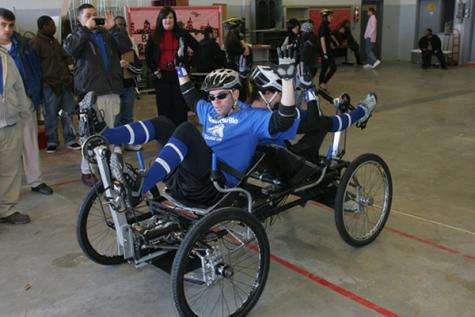King of the (lunar) road

The University of Alabama in Huntsville’s moon buggy may not go from 0 to 60 in five seconds, but it can handle the lunar regolith like nobody’s business. And that’s no small feat, says mechanical and aerospace engineering professor Dr. Christina L. Carmen.
“The lunar regolith has a lot of different consistencies, and at the surface, it’s fine, jagged, and rough,” says Carmen. “Add to that the moon’s craters and sand pits, and it takes a lot of manpower to go through those.”
Carmen has served as the faculty advisor for the UAHuntsville’s moon buggy team since the 2008/2009 academic year. The team, she says, “is a group of students who design, analyze, fabricate, and test a vehicle to compete in NASA’s annual Great Moon Buggy Race at the U.S. Space & Rocket Center.”
Dr. Carmen has been the advisor since 2009. She took over from retired engineering professor Gerald Karr. But because “it was almost the same team as the previous year,” she says, “I just let them do it the way they were doing it and provided support when needed.”
The team decided to build a whole new moon buggy with materials typically used in aerospace engineering. “They experimented with composites and designed a beautiful, very unique vehicle,” says Carmen. “It was very good experience, and it really set the UAHuntsville team apart from all the other teams. I haven’t seen any other team that used as much composites as the UAHuntsville team.”
Nevertheless, “they didn’t win,” says Carmen. Just as in the previous year, the team completed the moon buggy the morning of the competition, leaving no time for a test run. They did, however, successfully finish the race, placing 11th out of 80 entries.
Inspired by that success, Carmen was willing to stay on as faculty advisor for the 2009/2010 academic year – but she knew something had to change. “I had a severe dilemma as to how they were progressing with the design and the schedule,” she says. “So my goal that year was to have the team complete the vehicle two to three weeks before the race date so that we could test it.”
To that end, she scheduled a series of design reviews. “The goal of these reviews was to force the students to complete the project,” says Carmen. “But it didn’t happen!” That year, as in years past, the team completed the moon buggy the morning of the competition. But they still managed to place 18th, and in addition, “we won two prestigious awards that recognized the design aspect,” says Carmen.
The first was for the best design in the university division. The second was for overall system safety, which was based on the report the team wrote to analyze the safety, hazards, and risks involved in the design of their moon buggy. “During the awards, a NASA engineer and judge said their design report read like a NASA report,” says Carmen. “We were flattered by that because it spoke to everything the team had learned and gone through.”
Once again, Carmen was motivated to stay on as faculty advisor for the 2010/2011 academic year. Being another year wiser, however, she told her students that she would do it “only if the team leadership was enrolled into the senior design class.” That way, she could associate a grade with the students’ ability to meet important milestones. “When you have a class grade involved,” says Carmen, “the students are more prone to meet their deadlines!”
This time it worked. “We’re less than a month out and already able to test the vehicle,” says Carmen. In fact, the team recently competed in a fun run on the test course at the Huntsville Center for Technology and “they did an amazing job,” she says. That bodes well for this year’s race, which will be held Friday and Saturday on a challenging 0.7-mile course littered with obstacles and hazards.
“A 0.7-mile course doesn’t seem very long, but when you’re two people going over such a difficult terrain, it’s exhausting,” says Carmen. To prepare, the drivers – who must be one male and one female per the competition rules – have been undertaking physical training. The team has also made some adjustments to last year’s moon buggy, which they’re reusing in order to stay within their $5,000 budget.
All that’s lacking now is a rabid fan base. “This team is actually trying to get the UAHuntsville Charger mascot and the cheerleaders to come to the competition to cheer them on, because it’s streamed live on the NASA website and it’s on the local news,” says Carmen. “Other school teams in the past have won the team spirit award, though it’s often Puerto Rico because they bring bongos!”
But even if they don’t win, Carmen knows that the students are getting much more out of the experience than a trophy. “I don’t compete in anything unless the goal is winning first place! But do I think that’s the most important aspect? No. You might consider that first team a ‘failure,’ but they learned so much about testing, safety, and composites,” she says. “That’s why you can’t be judged by where you place, but rather by what the students learned.”
As for what next year will bring, Carmen says she plans to stay on as faculty advisor. After all, “students are not quite as jaded as ‘older folks.’ To them, almost everything is possible.”
Provided by University of Alabama in Huntsville

















